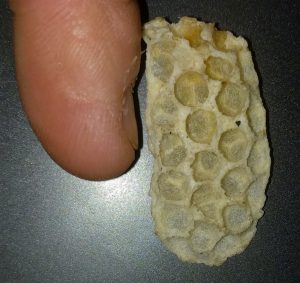Second swarm from Hive 2 – June 15, 2018
Okay. No false humility this time. These little beggars have me completely baffled. I’m writing down the events of the last couple of days so that I’ll remember them in the hope that the bees might be able to drill some small beekeeping lesson into my pea brain.
About mid-afternoon on Thursday June 14, 2018, while I was working on our new coop, Sue called out to me from the barn, pointing at the row of bee hives. I had seen swarms which had already perched somewhere, but I had never seen a swarm in progress. Our Hive 2 colony – a gift from a friend to replace one of the colonies we lost over the winter of 2017/2018 – was swarming. They were gathering in a tree about 50 feet away from the hive. Since I don’t particularly want more colonies right now, and knowing that the nectar flow in our area is drying up rapidly, I called my friend and asked her whether I ought to try to capture the swarm, or just let them go. She advised capturing it in case Hive 2’s new virgin queen doesn’t return from mating, or is otherwise inadequate to the task of keeping her colony going. I would then be able to reintroduce the original queen back into the colony.
By this time, the swarm had pretty much settled into the tree. It was quite large – about enough to fill a 10-frame deep box completely. It was also clustered in two separate balls about 2 feet apart along the same branch, but the inboard ball was much smaller than the one near the end of the branch. After the swarm settled, we cut off the branch and shook the bees off into a large plastic tote. The bees were naturally very upset, but we quickly took them over and shook them into our horizontal hive right next to their original home. This was a bad choice, as I realized later. I was expecting the bees would spread out into the frames of the new box, and that they would begin to fan to draw the rest of the swarm to them. This never happened. Instead, a melee broke out between the swarm, and the other colony living on the other side of the division board in the horizontal box. There was also a considerable “orphan” ball still up in the tree. We tried several times to shake these down into the tote and move them into the target horizontal with limited success. At the end of the afternoon, a large cluster was hanging on the front of the original hive, and activity at the entrance of the target hive was minimal. There was also an orphan ball about the size of a softball still up in the tree.
The next morning – June 15, 2018 – at first light I went out to check on them, and found the cluster still hanging on the front of the original hive. It was almost as big as the main swarm, but not quite. Opening up the target hive next door, I found it nearly empty as suspected, so I removed the empty frames, closed the entrance, and moved the division board back to its original place. This time, we took one of our swarm traps made out of two old deep nuc boxes bolted together, brushed the bees from the front of Hive 2 into that, and filled the top with one old brood frame and four empty foundationless frames. We managed to catch most of the ball on the front of the original hive into the swarm trap, but a good number of them dropped onto the entrance board. We tried to brush those into the swarm trap, again with limited success. We closed up the swarm trap, opened up its entrance disc, and set it down next to the hive in the hopes we had captured the original queen, and the bees would begin to fan their siblings into the swarm trap. After a few minutes, they had settled down, but we never saw the concerted “march” into the new hive that we were hoping for. I then closed up the swarm trap entrance, and hung it up in the tree where the first swarm settled, in the hopes its proximity would draw the orphan ball into the new colony.
Thinking we had at least a temporary solution, I went back to work on the coop, trying to get a new steel roof hung on it before the afternoon thunderstorm I could hear in the distance arrived. After about an hour and a half, I went back to check on the orphan ball. It was gone, so I assumed they’d gone into the swarm trap. There was activity at the swarm trap entrance, but not as much traffic as I’d expected to see. Then about an hour later, Hive 2 swarmed again. I am completely clueless whether this was a secondary swarm, or another attempt by the original swarm. Since we never saw a “march” into the swarm trap, I suspect the bees living in it are all orphans. I quickly ran out to Johnson’s Bees and Supplies to buy two 10-frame deep boxes since we already had a 10-frame bottom board, inner cover, and top cover on hand. We set this new hive under the swarm branch, with the bottom box populated with frames, and the top box empty. We carefully cut off the branch the swarm was on, brought it down to the hive, shook the swarm into it, and quickly closed the cover.
This time, the bees almost immediately began fanning at the entrance, drawing the rest of the swarm inside. So we know we have a queen in this new double-deep, but what queen it is I haven’t a clue. I suspect (hope) that she is the original mated queen from Hive 2, but won’t have any way of knowing until we check for eggs (and probably add a feeder) in a few days after they’ve had a chance to settle in.

Having been advised by a friend not to leave that top box empty for very long, I built enough new frames to populate it after our Bible study Friday night. I went out to check on the new hive and place these new frames inside this morning (Jun 16, 2018) as soon as it started getting light. I’m glad I did. The bees had already begun propolizing the inner cover down, of course, so the cover popped open with a little jerk. This was fortuitous, because when I opened up the inner cover I found the bees had all clustered underneath rather than on the frames of the bottom box. When the cover snapped off, most of them dropped onto the frames below. They had also already begun building comb on the underside of the cover, as shown in this photo. I quickly filled the top box with empty frames along with an empty honey frame we had left over after extracting earlier this spring.
They have settled down again now, with “ordinary” coming and going at the entrance. There is very little activity so far this morning at the swarm trap less than 10 feet above the new hive, so I suspect I will find it empty tomorrow when I check it. I also suspect I will find eggs right away in the new hive, because I believe the swarm we captured into it is the original primary swarm that we thwarted by trying to move them back too close to their original home. But like I said, at this point I’m completely confused. It all sounds so easy in the books, in the bee club presentations, and on the websites.

Quick update. As of August 1st, both Hive 2 and the third swarm it threw are queenright. Either the remaining queen in the mother box was already mated when the swarms were cast, or she was quickly laying after her mating flights. The first two swarms this hive generated were given away, and the person who took them found that they had combined themselves and had a laying queen within a couple of days after he picked them up. We knocked the third much smaller swarm into a swarm trap box which we then hung up on the same tree where they originally lit after swarming. We left that trap up for a few days, then transported it a few miles away and transplanted all the frames into a nuc box. When we brought the new hive back home about a week later, we had eggs on the single occupied frame, and saw the mated queen. I don’t know if she was already mated when we took her out of the swarm trap or not. That colony started with a single drawn and occupied frame. We began feeding them when we returned them home about 2 weeks ago, and they have drawn new comb onto half of the foundationless frame next to the original occupied frame. They have done little with the third frame in that nuc, and the division board feeder takes up the remaining two frame spaces in the nuc.
Oh no! – Too late.
Did a quick check inside Hive 2. Found 5 queen cells recently emerged, and several more still capped – one of which showed signs of an imminent emergence. We hooked all of them out. We also saw at least 4 walking virgin queens and heard at least one piping queen. It may be too late to keep these girls from swarming again.
Status update – Unexpectedly, there is activity in and out of the swarm trap. I suspect these bees may be orphans. Either that, or we have had both a primary and secondary swarm. If they are orphans, I’m looking for advice on how to re-integrate them into mainstream society after their brief incarceration. If they have a queen, we will need to re-home them into a nuc we have on hand. Given my dismal rate of success in finding queens, and since one or the other queen in these two swarms (assuming we had a primary and secondary swarm) is a virgin. How will I be able to tell if the swarm trap swarm is queenless or not?